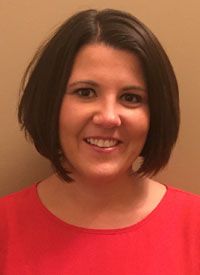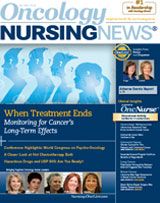For Survivors of Childhood Cancers, Specialized Support Can Make All the Difference
More people are living at least 5 years after their original pediatric cancer diagnosis than ever before. According to the Childhood Cancer Survivor Study (CCSS), 400,000 childhood cancer survivors are alive today, and that number is expected to grow to half a million by 2020.
Kyla Alsman, RN, BSN

Kyla Alsman, RN, BSN
More people are living at least 5 years after their original pediatric cancer diagnosis than ever before. According to the Childhood Cancer Survivor Study (CCSS), 400,000 childhood cancer survivors are alive today, and that number is expected to grow to half a million by 2020.1
But this recent progress in beating childhood cancers is also countered by some sobering statistics.
The American Cancer Society reports that two in three survivors of childhood cancer experience debilitating late effects from their treatment. These can include fertility issues, cardiovascular disease, pulmonary problems, endocrine issues, metabolic syndrome, growth delays, as well as second malignancies.
To serve this population of at-risk survivors, more and more survivorship clinics have been opening around the country to regularly monitor, educate, and support patients.
“We know survivors are living longer and are at increased risk for late effects. At the University of Kansas Cancer Center Survivorship Transition Clinic (KUCC STC), we provide comprehensive care that includes screening for late effects and providing education to minimize their risks and promote a healthy lifestyle,” explained Kyla Alsman, RN, BSN, nurse navigator at KUCC STC.
Of the nearly 400,000 childhood cancer survivors, about 70% are estimated to have a mild or moderate chronic condition, and about 32% are estimated to have a severe, disabling or life-threatening chronic condition.2
An estimated 35% of the survivors, aged 20 to 49, had neurocognitive dysfunction, and about 13% to 17% of those in this age group had self-reported functional impairment, activity limitations, impaired mental health, pain, or anxiety and fear.
“We know that many of these morbidities are at least somewhat modifiable in the general population. However, we don’t know if typical population guidelines for preventive behaviors apply to this group,” lead author Siobhan M. Phillips, PhD, MPH, assistant professor of preventive medicine at Northwestern University Feinberg School of Medicine, said in a statement.
“We need to develop a better understanding of the multilevel factors including, but not limited to, physical activity, diet, and treatment characteristics, which influence childhood cancer survivors’ susceptibility to these morbidities in order to effectively prevent and delay their onset.”
Customizing the Treatment Plan
Like other similar clinics, the health professionals at the Survivorship Transition Clinic work
 to prevent such morbidities by following the Children’s Oncology Group Long-Term Follow-Up Guidelines for Survivors of Childhood, Adolescent, and Young Adult Cancers, which is available online and is a useful tool for all pediatric oncology nurses, Alsman noted.
Using the patient’s medical records, a consolidated treatment summary is made which includes demographics, past diagnoses, treatment, surgeries, and any late effects or symptoms. From there, health professionals at the clinic can screen for specific risks based on the patient’s treatment, educate them on how to minimize the risk, and provide information about further tests or specialist care if necessary.
“Based on the treatment summary and the survivorship guidelines, we are able to determine appropriate screenings for each survivor,” Alsman said. For example, patients who received cardiotoxic chemotherapy and/or chest radiation need to have frequent echocardiograms. Some chemotherapy agents and chest radiation may impact a survivor’s lung function which requires pulmonary function tests for screening. Many young adult survivors are concerned about the effects of treatment on their fertility. We will refer them to a reproductive endocrinologist for further screening and education.
“As a navigator, I help them make all of these appointments because it can be overwhelming for some of these patients. Trying to navigate a large healthcare system can be anxiety provoking, so being able to be that person of contact for them has really helped.”
Findings of a recent study showed that survivorship care is associated with increased knowledge of diagnosis, treatment history, and risk of late effects.3
Researchers asked childhood cancer survivors from a single-institution survivorship clinic and survivors receiving routine follow-up care about diagnosis, age, and their time of therapy. The study found that survivorship participants were more likely than those receiving routine care to correctly report their diagnosis and indicate a previous discussion of risks of late effects.
And not only are survivorship clinics beneficial to patients, but they’re desired by survivors as well, according to a research project done by Alsman’s colleagues from Midwest Cancer Alliance (MCA), the outreach arm of The University of Kansas (KU) Cancer Center, and Children’s Mercy. The project, which prompted the development of the Survivorship Transition Clinic, revealed that of 272 young adult survivors who had been treated at KU Medical Center or Children’s Mercy, 52% wanted more information about what late effects to expect, and 47% wanted more information on how to deal with such late effects, including what tests were necessary.
The clinic, which opened November 2014, was established through collaboration with MCA, KU Medical Center, and Children’s Mercy.
“Prior to developing the survivorship transition clinic, patients 21 years and older were transitioned to their primary care provider,” said Alsman. Research shows primary care physicians may not feel comfortable caring for childhood cancer survivors because of a lack of familiarity with their unique needs and that primary care providers prefer to care for survivors in collaboration with providers who are more familiar with the survivorship guidelines.”
“The collaboration between KUCC, MCA, and CMH allows the transition to be seamless as survivors transition to the adult setting. In my role I spend time at Children’s Mercy Hospital and the KUCC Survivorship Transition Clinic to help minimize anxiety related to transition. This allows me to establish a relationship with patients during their appointment at CMH, and also provide continuity as they transition to the STC at KUMC.”
The Survivorship Transition Clinic has grown over the past year, expanding its clinic hours and adding patients. “It’s sad that that many people need care, but it’s exciting that we’re able to provide that care,” Alsman said.
Psychosocial Effects, Too
At UC Davis Comprehensive Cancer Center in Sacramento, California, Kathryn Wells, RN, MS, CPNP, CPON, cares for pediatric patients at the center’s GREAT (Getting Regular Evaluations After Treatment) clinic.
Established back in
the 1980’s, GREAT was revised in 2012 to monitor late effects and survivorship issues in a for- mal way rather than on a case-by-case basis as it was done in the past. The program uses an innovative computer tool known as Passport for Care to help predict the kinds of late effects patients may face as a result of their treatment, and guides clinicians, patients, and their families on how to watch for and manage them.
“The intensity of the treatment makes it important for us to have these late effects clinics because we’ve not just cured their cancer or made them cancer free, but we’ve given them treatments that really can have effects on their health,” Wells said. “It’s a process that we need to start when they finish their treatment, and we need to educate them because it will be some- thing that they live with for the rest of their lives beyond when they come to see us in pediatric oncology.”
Along with screening for late effects, many survivor clinics have also begun to address psychosocial needs, bringing in social workers and psychologists and using distress screening thermometers. Another area that’s proven to be troubling for some young survivors can be their academic performance.
“These kids just don’t learn like their siblings do. It’s not that they can’t learn, but there are specific effects that we see. We see a much higher rate of problems with inattention, problems with processing speeds, and executive functioning,” Wells explained. “These kids really need
to be followed closely in their schooling to make sure that they get the resources that they need to be successful.”
And as far as making her patients comfortable and encouraging them to follow up, Wells says, that’s basically her job description.
While the old model of announcing to a patient that they’re cancer free and throwing a party is a nice idea, she said, it’s an injustice to the patient. Rather, Wells sits down with her patients and explains the risks as well as modifiable risk factors and things that they can actively do to stay healthy.
“I try to put everything into perspective for them in a very, very concrete way. I take that big scary thing—recurrence—and try to break it down for them into pieces that they can grasp onto,” she said. “We need to help patients and families understand that it’s important that the last day of chemo is not the last day they see us.”
Passport for Care
Passport for Care was developed by Marc Horowitz, MD, a pediatric hematologist oncologist at the Texas Children’s Cancer Center, in collaboration with the Baylor College of Medicine in Houston, Texas, where he is a professor in the Department of Pediatrics, Hematology-Oncology section, and the Children’s Oncology Group, an NCI— supported clinical trials group.
It is an interactive Internet resource that provides the user with accurate, timely, and individualized healthcare information by assembling survivor care recommendations that are individualized based on the survivor’s treatment history. It also provides end- of-treatment care summaries and customized educational resources.
The Passport for Care application, now available to Children’s Oncology Group (COG) member institutions, is currently being used by 120 clinics throughout the United States. More than 60 additional Children’s Oncology Group member institutions are undergoing the implementation process and the Passport for Care application has been used with over 15,000 patients to provide care summaries and guidelines to practitioners in the clinics.
To learn more about the program, visit http://bit.ly/1LTsQth.
For more on the Children’s Oncology Group Guidelines:
http://www.survivorshipguidelines.org/
For a list of survivor follow-up clinics:
http://www.ped-onc.org/treatment/surclinics.html
REFERENCES
1. Armstrong GT, Yasui Y, Chen Y, et al. Reduction in late mortality among 5-year survivors of childhood cancer: A report from the Childhood Cancer Survivor Study. J Clin Oncol. 2015;(suppl; abstr LBA2).
2. Phillips SM, Padgett LS, Leisenring WM, et al. Survivors of childhood cancer in the United States: prevalence and burden of morbidity. Cancer Epidemiol Biomarkers Prev. 2015 Apr;24(4):653-663.
3. Lindell RB, Koh SJ, Alvarez JM, Koyama T, et al. Knowledge of diagnosis, treatment history, and risk of late effects among childhood cancer survivors and parents: The impact of a survivorship clinic. Pediatr Blood Cancer. 2015 Aug;62(8):1444-1451.

Innovative Program Reduces Nurse Turnover and Fosters Development
Published: September 12th 2024 | Updated: September 12th 2024The US Oncology Network (The Network) has developed one of the most comprehensive programs in the nation to support the professional development and retention of new oncology nurses.


